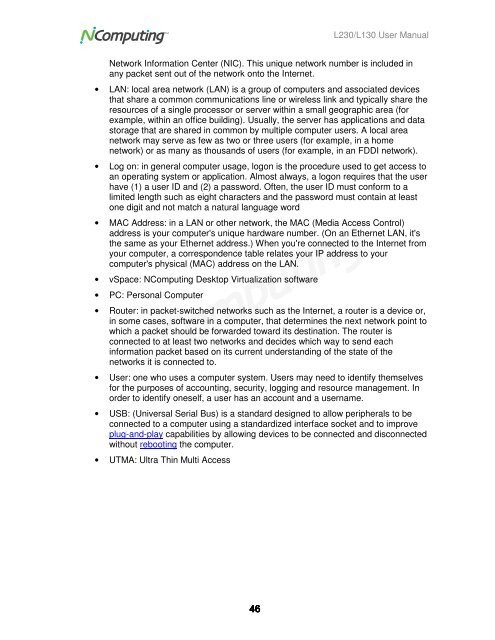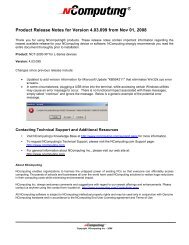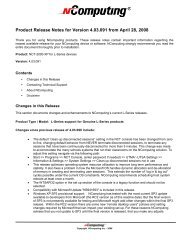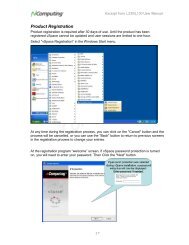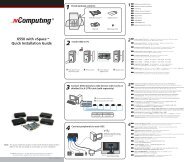L230 and L130 Access Devices with vSpaceTM User Guide
L230 and L130 Access Devices with vSpaceTM User Guide
L230 and L130 Access Devices with vSpaceTM User Guide
You also want an ePaper? Increase the reach of your titles
YUMPU automatically turns print PDFs into web optimized ePapers that Google loves.
<strong>L230</strong>/<strong>L130</strong> <strong>User</strong> Manual<br />
Network Information Center (NIC). This unique network number is included in<br />
any packet sent out of the network onto the Internet.<br />
• LAN: local area network (LAN) is a group of computers <strong>and</strong> associated devices<br />
that share a common communications line or wireless link <strong>and</strong> typically share the<br />
resources of a single processor or server <strong>with</strong>in a small geographic area (for<br />
example, <strong>with</strong>in an office building). Usually, the server has applications <strong>and</strong> data<br />
storage that are shared in common by multiple computer users. A local area<br />
network may serve as few as two or three users (for example, in a home<br />
network) or as many as thous<strong>and</strong>s of users (for example, in an FDDI network).<br />
• Log on: in general computer usage, logon is the procedure used to get access to<br />
an operating system or application. Almost always, a logon requires that the user<br />
have (1) a user ID <strong>and</strong> (2) a password. Often, the user ID must conform to a<br />
limited length such as eight characters <strong>and</strong> the password must contain at least<br />
one digit <strong>and</strong> not match a natural language word<br />
• MAC Address: in a LAN or other network, the MAC (Media <strong>Access</strong> Control)<br />
address is your computer's unique hardware number. (On an Ethernet LAN, it's<br />
the same as your Ethernet address.) When you're connected to the Internet from<br />
your computer, a correspondence table relates your IP address to your<br />
computer's physical (MAC) address on the LAN.<br />
• vSpace: NComputing Desktop Virtualization software<br />
• PC: Personal Computer<br />
• Router: in packet-switched networks such as the Internet, a router is a device or,<br />
in some cases, software in a computer, that determines the next network point to<br />
which a packet should be forwarded toward its destination. The router is<br />
connected to at least two networks <strong>and</strong> decides which way to send each<br />
information packet based on its current underst<strong>and</strong>ing of the state of the<br />
networks it is connected to.<br />
• <strong>User</strong>: one who uses a computer system. <strong>User</strong>s may need to identify themselves<br />
for the purposes of accounting, security, logging <strong>and</strong> resource management. In<br />
order to identify oneself, a user has an account <strong>and</strong> a username.<br />
• USB: (Universal Serial Bus) is a st<strong>and</strong>ard designed to allow peripherals to be<br />
connected to a computer using a st<strong>and</strong>ardized interface socket <strong>and</strong> to improve<br />
plug-<strong>and</strong>-play capabilities by allowing devices to be connected <strong>and</strong> disconnected<br />
<strong>with</strong>out rebooting the computer.<br />
• UTMA: Ultra Thin Multi <strong>Access</strong><br />
46


